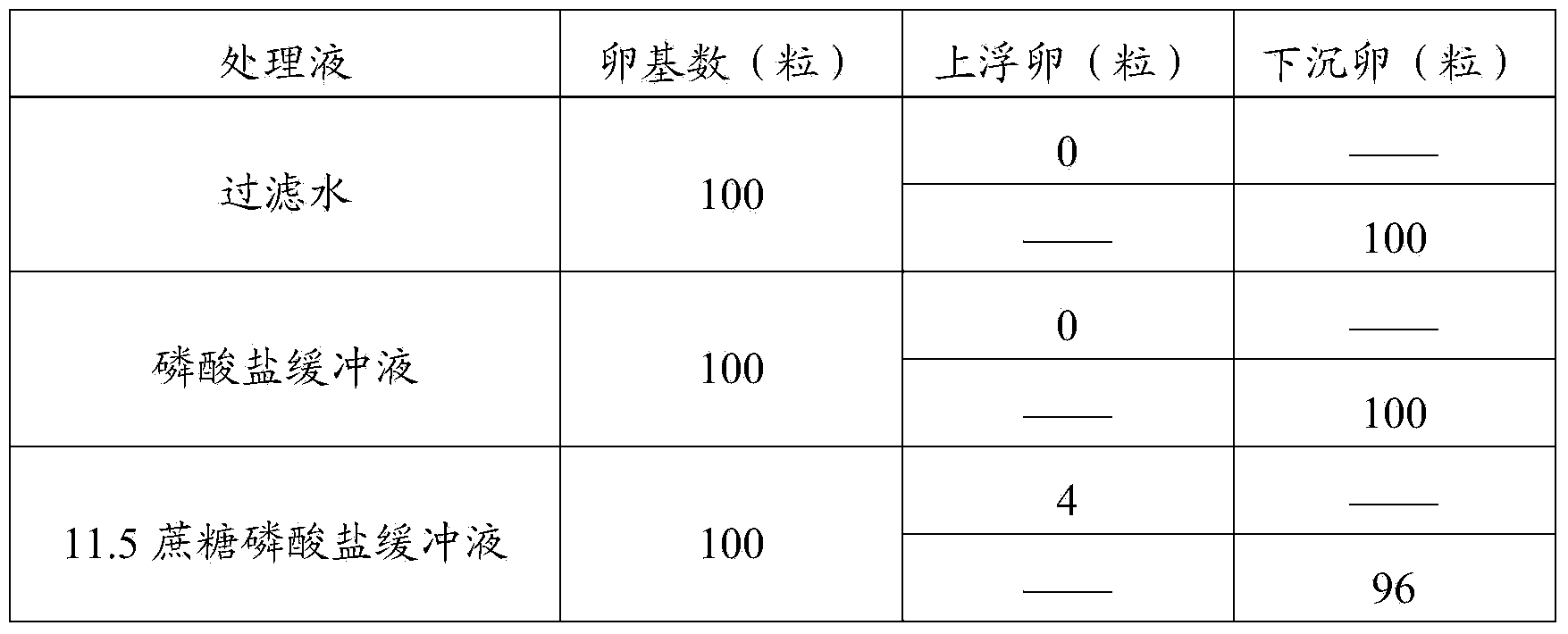Liquid and method for screening hepialus armoricanus eggs
A technology of bat moth eggs and screening methods, applied in botany equipment and methods, horticulture, application, etc., can solve the problem that there is no effective classification of bat moth eggs, and achieve the effect of increasing hatching rate and increasing hatching rate
- Summary
- Abstract
- Description
- Claims
- Application Information
AI Technical Summary
Problems solved by technology
Method used
Image
Examples
Embodiment 1
[0047] Sucrose phosphate buffer solution to detect egg effect:
[0048] Get the first batch of bat moth eggs, get 3 portions of eggs altogether, each portion of 100 grains.
[0049] Two copies of eggs A1-1 and A1-2 were taken and dissected to check the development status. The results are shown in Table 1 below.
[0050] For the other 100 eggs A2, adjust the sucrose content in the screening solution to 1%, 10%, 15% and 20%, take 5mL of the solution respectively, and transfer it into a 10mL centrifuge tube. The bat moth eggs were sampled as a whole and immersed in the test solutions of several sucrose concentrations successively from low to high. Put the eggs into each centrifuge tube, turn it upside down 6 to 8 times, and wait for it to sink. Eggs on the floating liquid surface of each treatment are taken out and placed in a Petri dish covered with filter paper marked with the corresponding mark, the filter paper is humidified, and then the eggs that sink to the bottom are pu...
Embodiment 2
[0116] The effect of adding taurine to sucrose phosphate buffer solution to detect eggs:
[0117] Get the same bat moth egg, a total of 4 eggs, each 100.
[0118] Set 15% sucrose 0.1mol / L phosphate buffer (PH=7) with concentration gradient between 0.2~1mmol / L taurine.
[0119] After each group of eggs were treated in phosphate buffered saline with different molar concentrations, the eggs were placed in the rearing substrate for rearing, and the number of larvae was counted in the substrate after 30 days.
[0120] The experimental results are shown in Table 10.
[0121] Table 10 The late effect of taurine with different molar concentrations and sucrose phosphate buffer compatibility on bat moth eggs
[0122]
[0123] According to the test results, adding 0.2-1.0mmol / L taurine to sucrose phosphate buffer solution, the hatching rate and survival rate of larvae are higher than those without adding taurine.
Embodiment 3
[0124] The preparation of embodiment 3 bat moth ovum screening liquid
[0125] Configure 1mol / L anhydrous sodium dihydrogen phosphate (NaH 2 PO 4 ) stock solution: dissolve 120g in sufficient water to make the final volume 1L;
[0126] 1mol / L disodium hydrogen phosphate (Na 2 HPO 4 ) stock solution: dissolve 142g in sufficient water to make the final volume 1L;
[0127] Take 1mol / L anhydrous sodium dihydrogen phosphate (NaH 2 PO 4 ) stock solution 877ml and 1mol / L disodium hydrogen phosphate (Na 2 HPO 4 ) were mixed with 123ml of the stock solution so that the pH of the mixed solution was 6.
[0128] After adding 3125g sucrose, add water to dilute 25 times to obtain a sucrose phosphate buffer solution with a salt concentration of 0.04mol / L (mass concentration of sucrose is 12.5%).
PUM
 Login to View More
Login to View More Abstract
Description
Claims
Application Information
 Login to View More
Login to View More - R&D
- Intellectual Property
- Life Sciences
- Materials
- Tech Scout
- Unparalleled Data Quality
- Higher Quality Content
- 60% Fewer Hallucinations
Browse by: Latest US Patents, China's latest patents, Technical Efficacy Thesaurus, Application Domain, Technology Topic, Popular Technical Reports.
© 2025 PatSnap. All rights reserved.Legal|Privacy policy|Modern Slavery Act Transparency Statement|Sitemap|About US| Contact US: help@patsnap.com



